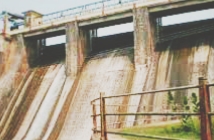Table of Contents
What Is Spillway?
Spillway is a device which is used to discharge extra water from the dam. It protects the dam from structural collapse. Spillway automatically discharges overflow.

Spillways that can be used to control reservoir level and water flow. By releasing water gradually before the reservoir is full, operators can prevent an unacceptably large release later. Such features allow a spillway to regulate downstream flow.
The term “spillway” is also used to describe outlet channels cut through natural dams, bypasses of dams utilized during high water, and exits of waterways.
Only during times of flooding, when the reservoir has reached its maximum capacity and water is coming in faster than it can be released, does water generally go over a spillway. An intake tower, on the other hand, is a structure that regularly regulates the release of water for uses like water supply and hydroelectricity production.
Types Of Spillway
1. Straight Fall Spillway
A straight fall spillway consists of a low-elevation weir wall with a nearly or completely vertical downstream side. When the water level in the reservoir rises above the water level in the normal basin, the excess water falls freely over the weir crest, hence the term straight-fall overflow or free-flow overflow.
Artificial reservoirs with concrete skirts and low secondary dams are constructed on the downstream side to prevent the downstream riverbed from being washed away by the falling jets. Adequate ventilation must be provided at the bottom of the falling jet to avoid pulsation and fluctuation effects.
2. Ogee Spillway
The Ogee Spillway, as the name suggests, represents the shape of the downstream side of the weir. It is an improved type of spillway. In this case, the downstream face of the weir is designed to the shape of the lower ceiling of the free-falling waterjet with an ogee shape. The outflow V-shape is designed according to the bullet principle.
3. Manhole Spillway
A manhole overflow is a type of overflow consisting of a vertical manhole followed by a horizontal channel. Excess water enters the shaft, then the horizontal line, and finally reaches the downflow of the canal.
Constructed wells are either artificial or natural. Drilling a natural shaft is only possible if there is a hard rock formation on the upstream side. The horizon line passes through the dam body or dam foundation.
4. Gutter Spillway
A chute overflow is a type of overflow that discharges excess water from upstream to downstream through a steep open channel. They are usually built at one end of the dam or away from the dam in the natural saddle of the river bank.
Chute overflow is suitable for gravity dams, earth dams, rockfill dams, etc. However, it is suitable for very narrow river valleys.
5. Side Channel Spillway
A side channel overflow is similar to a sliding overflow, the only difference is that the crown of the side channel overflow is on one of its sides and the crown of the sliding overflow is between the sidewalls. In other words, the water exiting the crest he rotates 90 degrees and flows parallel to the crest of the side channel spillway, unlike the sliding spillway.
6. Siphon Spillway
A siphon he overflow is a type of overflow that drains excess water downstream through an inverted U-shaped pipe. It is usually located inside the body or above the perineum.
Both types of siphon weirs have vents in the curved portion of the upper channel to prevent water ingress when the water level drops below normal pollen levels. When the water level exceeds the normal pool level, water enters the line and is discharged down the channel by siphoning action.
7. Labyrinth Spillway
A labyrinth weir is a type of weir that has a zigzag weir wall and an effective length of the weir crest relative to the width of the channel. This increased effective length increases the drainage capacity of the weir, thus allowing higher flow rates of water to be carried downstream more easily with a smaller head.
Design Requirements for a Spillway
- Spillway needs to be structurally and hydraulically sound.
- The spillway needs to be big enough.
- It must be situated in a way that allows for the secure disposal of water.
- To survive the high scouring velocity produced by the drop from the reservoir surface, the surface of the spillway must be erosion-resistant.
- For energy dissipation on the downstream side of the spillway, a device is typically needed.
